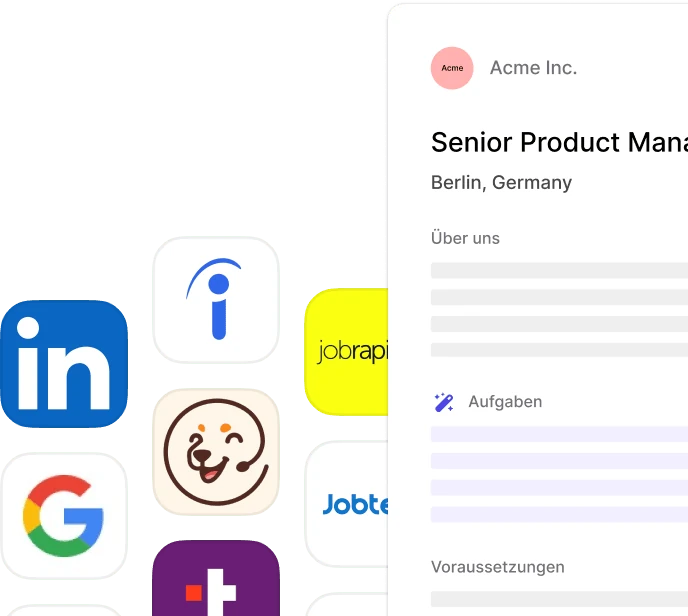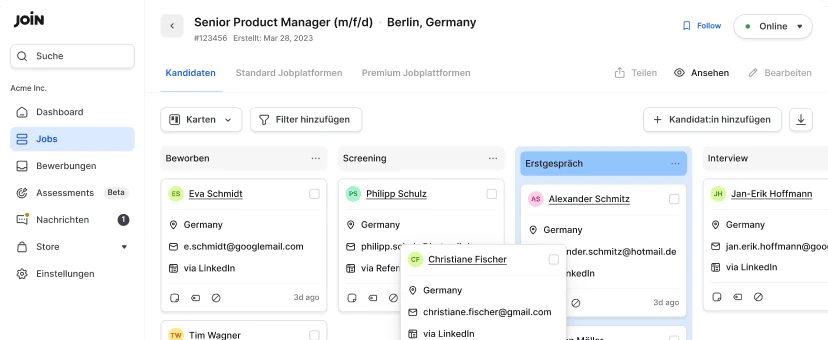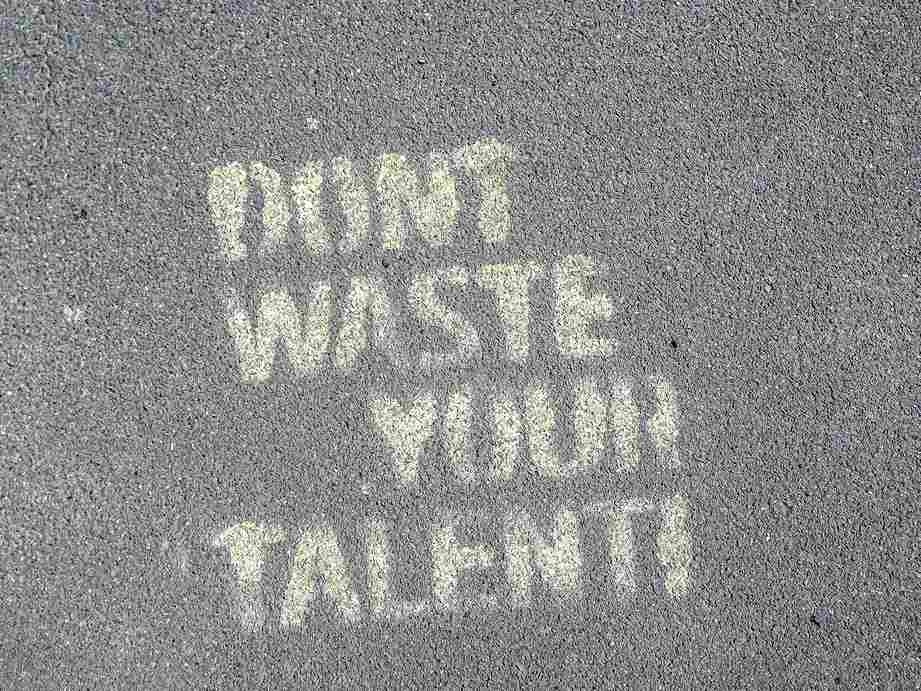Helpful employee selection methods to hire better talent
Table of contents
Choosing the right employees for your business might sometimes feel as challenging as finding a needle in a haystack. However, equipped with the right employee selection methods and tools, the task need not be as daunting.
Table of contents
These systematic candidate selection techniques not only simplify the hiring process but also ensure that you secure the best talent for your organisation. It’ll allow you to identify the cream of the crop more easily.
With help from this article, you’ll be able to perfect your candidate selection methods and find the right employee selection tools for hiring top talent that fits meets your needs.
So let’s dive deep into the world of employee selection.
What is employee selection in the recruitment process?
Before you can know what those employee selection methods in hiring are, you need to know what employee or candidate selection itself is.
Simply put, it’s what helps you identify candidates with the highest potential to become the new employees you’re after. To achieve this, recruiters and hiring managers use a set of strategies or techniques to sift through a pool of applicants to select and hire the best candidate for a specific job role.
This process includes analysing each applicant’s unique blend of skills, experiences, qualifications, and cultural fit to determine who is the right choice for your organisation. As such, employee selection is an integral part of the larger hiring process.
To give an example, probably the most common selection technique is to conduct candidate interviews. An interview is a way to get to know a candidate and see if they are right for the job. It’s what helps you not only identify candidates, but identify suitable candidates.
Why using multiple candidate selection methods in your hiring process is important
You might wonder, “Why do I need to put so much thought and effort into employee selection?” After all, it’s just a part of the wider recruitment process.
Why add a bunch of filters and extra steps when the process can simply be a matter of:
- Post a job ad on online job boards
- Get applications
- Check their CVs
- Interview candidates
- Hire the best one
Well, the answer is straightforward: A subpar hiring decision can cost your business a lot of time and money.
Moreover, it can lead to reduced productivity, increased employee turnover, strained team dynamics, and even damage to your company’s reputation.
Conversely, choosing the right individual through careful candidate selection can lead to a significant boost in team morale, enhanced productivity, and, ultimately, robust business growth.
Hence, the best employee selection methods are an investment in the future success of your organisation. They are far from a mere administrative function; they are a critical strategic initiative.
8 of the most-effective employee selection methods
So let’s start improving your hiring process by giving you the right tools for the selection of those top candidates. And that includes using these eight tried-and-tested personnel selection methods.
Let’s explore these strategies and see how they can bring top-tier talent to your company.
1. Screening questions and job application forms
The best candidate selection process starts already during the application process.
Before you (or your recruiter) even gets in touch with a potential new employee you can already ensure they are somewhat pre-selected. The easiest way to do this (aside from using relevant niche job boards or similar other targeted talent acquisition strategies) is to ask applicants to answer certain questions during the application.
Such job application screening questions automatically separate the wheat from the chaff, without you having to go through applications or contact applicants. Example questions include “Are you currently legally permitted to work in [insert country]?” or “What is your expected salary range?”
Do note that you should only ask questions related to the role and that do not discriminate against people. For example, you’re not legally allowed to ask for someone’s age in the screening questions. For more information on fair screening, check our article about fair shortlisting made easy.
Using dedicated software, like JOIN’s free hiring tool, you can easily create an application form with pre-suggested screening questions. Once your job ad is live, applicants will be automatically asked to answer the questions during the application. If they answer a question incorrectly, the software automatically sends the applicant a rejection email.

2. Resume screening
One of the most common selection methods in recruitment that will come to mind for most people is resume or CV screening.
This is the (manual) practice of reviewing the resumes of those who applied to your job opening. During this part of the hiring process, the recruiter checks the CV for any red flags and if the skills and experience listed meet the requirements listed in the job description.
To help speed up the process, most recruitment and selection systems offer resume parsing functionality. This is an automated way for the selection software to extract certain information, such as candidate name or education, from resumes and convert it into a structured format.
This means the recruiter or hiring manager doesn’t have to open every CV file separately to find the relevant data. Instead, all candidate data is gathered in an easy overview inside the software.
When still in doubt, the recruiter may sometimes contact the applicant via email, phone, or short video call to ask follow-up questions.
3. Use different types of interviews
Let’s start by dissecting one of the oldest and yet most effective employee selection methods in HRM: interviews. As a hiring manager, one of the best ways to understand a candidate’s suitability for a role is through interviews.
You can mix and match various types of interviews to gain a holistic understanding of the candidate’s skills, personality, and ability to handle situations. Here are a few types of interviews you might consider:
- Structured interviews: These are interviews where you ask each candidate the same predetermined set of questions, facilitating easier comparisons between applicants.
- Unstructured interviews: These are less formal, allowing the conversation to flow more organically. This flexibility can provide a deeper understanding of the candidate’s personality and thought process.
- Behavioural interviews: Here, you ask candidates to provide real-life examples from their past that demonstrate specific skills or behaviours. This gives you a more concrete sense of how they might perform in your work environment.
- Situational interviews: In these interviews, you present hypothetical scenarios to the candidate to gauge how they might respond to specific situations they could face on the job.
- Group Interviews: Evaluating multiple candidates simultaneously can help assess how candidates interact with others.
- Panel Interviews: Involving multiple interviewers can offer diverse perspectives on the candidate’s suitability for the role.
Each interview type has its strengths, and using a mix can provide a more comprehensive evaluation of a candidate’s suitability for a role. Note that whether it’s a virtual interview or an in-person interview should, when done right, not affect the effectiveness of the interview.
4. Skills tests and assessments
Another excellent method for evaluating a candidate’s suitability is through various tests and assessments. These employee selection methods can give you a more objective measure of an applicant’s abilities. For all these tests, ensure that they are job-relevant, fair, unbiased, and non-discriminatory.
A first example of a popular test employers conduct to help them in the candidate selection process is a skill test or skill assessment. This type of assessment can take many forms and lengths, but the ultimate goal is to test the (technical) skills of your job candidates to make comparison and candidate selection easier.
Specific tests can evaluate a candidate’s hard skills, such as their coding ability for a software development position or their writing ability for a content creator role.
If you decide to provide such a test, ensure it is relevant to the role you are hiring and selecting a potential employee for. Often, hiring managers send the assessment via email to a few shortlisted candidates or directly after a first interview with a candidate.
Ensure to include a rough estimate of the time the candidate should spend on the skills test and provide a clear deadline for when to submit the result. In some cases, employers may ask candidates to complete a short, 30-minute to 1-hour assessment during the actual interview, although this is a less common employee selection method.
5. Cognitive strengths or cognitive ability tests
These assessments measure a candidate’s thinking skills, including problem-solving, logical reasoning, and decision-making abilities. Again, the specific type of test you use here will depend on the job you’re hiring for, but also the industry you’re in.
For example, a perceptual speed and accuracy test tests how quickly a candidate can select the correct answer. Having a candidate perform this test shows you how they perform under pressure and how quickly they can perceive and interpret new information.
This helps with employee testing and selection for a job that requires ordering, sorting, and verifying information quickly, such as an Order Picker working in a warehouse.
6. Personality assessments
Personality tests can give you insight into a candidate’s behavioural style and how it could impact their work performance and interactions with the team. Such personality tests generally divide people into certain personality types based on their responses to a set of questions.
By knowing more about the personality type of a potential employee and how they might interact with others at your company, you can get a clearer understanding of whether the person will fit into your team (cultural fit). It will identify a candidate’s ability or help highlight their communication skills.
However, some argue that such practices are more prone to lead to biased decisions and candidates being discriminated against due to certain personality traits rather than their ability to perform the job.
7. Job simulations
Job or work simulations allow candidates to perform tasks related to the job they’re applying for. This can give you a more realistic view of their skills and how they would perform on the job.
Although job simulations are very similar to skill assessments (and often used interchangeably), there is a slight difference. A skills test is often related to the job that the company is selecting a candidate for, but it tends to be a bit more generic and less immersive. A job simulation, on the other end, lets the candidate solve an actual task of the new job at hand.
For example, a job simulation task would be to let the candidate create a set of Jira tickets to report issues to another department within the company. Such simulations are highly relevant and realistic, given the company valuable insights into how working with this person on a day-to-day basis will look like.
This helps make the employee selection process easier for the hiring manager as they get a real sense of what to expect from a potential future employee.
8. Perform background and reference checks
Lastly, depending on the role and industry, you may want to perform references and background checks. These checks can offer invaluable insights into a candidate’s past performance, work habits and behaviour, but also if they have a criminal record.
This helps you paint a more complete picture of the candidate while – depending on the position – also ensures you are following legal guidelines. For example, in many countries, if you are hiring a carer for a children’s daycare, an applicant is legally obligated to disclose and share any criminal record they might have.
Checking a candidate’s references can further corroborate information shared during the interview and identify any potential red flags. Often, candidate reference checks are performed by sending a reference an email or organising a quick call with them.

Harnessing the power of employee selection tools
We’ve already highlighted some candidate selection solutions above that will help your hiring team find the most suitable candidates. But let’s quickly give you a further overview of what helpful selection tool for recruitment is out there.
Applicant tracking systems (ATS)
An applicant tracking system is a powerful tool that can streamline the hiring process by automatically sorting and filtering resumes based on specific criteria.
This helps you identify the most promising candidates more efficiently, this speeding up your selection process. As the name suggests, a big part of an ATS is to help you track applicants as they move through your hiring pipeline.
For more information, check out our page: How an applicant tracking system can help your business!
Video interviewing and scheduling software
With the rise of remote work, video interviewing solutions have become essential. Platforms like Zoom or Microsoft Teams allow you to interview candidates from anywhere in the world. They can also provide options for recording interviews, which can be useful for further analysis.
Even better is finding a dedicated recruiting software solution that integrates interview scheduling inside its wider recruitment suite (like JOIN). This means your interview scheduling and further hiring process can all be combined within the same platform.
Skills assessment platforms
There are a lot of platforms out there that offer pre-created and tested skill assessments that you can use to assess candidates. These tools can provide an objective measure of a candidate’s abilities and help identify who has the necessary skills for the job.
Personality assessment solutions
Popular examples of personality tests include the Myers-Briggs Type Indicator (MBTI), the Dominance, Influence, Steadiness, and Compliance (DISC) test, and the Caliper Profile test.
Such solutions can provide insights into a candidate’s behavioural style and how they might fit within your team. They can complement traditional interviews by giving a different perspective on a candidate’s potential performance and fit.
Background check services
Background check services are essential for verifying a candidate’s past employment, educational credentials, and criminal record. These tools can ensure the information provided by the candidate is accurate and help mitigate potential risks.
General HR analytics tools
Although much broader in scope, general HR analytics tools can provide valuable insights into your selection and hiring process, such as time to fill a position or the quality of hire.
Insights into such important recruitment KPIs can help refine your selection methods over time so you get better and more efficient at identifying the best-qualified candidates.
Further perfect your candidate selection process
In a nutshell, employee selection methods are the essential tools in your recruitment toolkit. From traditional face-to-face interviews to easy-to-use skills testing tools, each technique offers unique advantages that can significantly enhance your hiring efforts.
By understanding and effectively leveraging these methods, you can streamline your hiring process, save valuable resources, and secure the top-tier talent that will help drive your organisation forward.
Remember, hiring is not just about filling a position; it’s about shaping the future of your company with the right people. Making effective use of employee selection methods helps you achieve just that. So, gear up, dive in, and make these methods work for you!
Want to get even better at recruitment? Then check out these extra resources:
Frans Lelivelt
Frans is JOIN's multilingual Senior Content Manager. His main topic of interest in the recruitment space is DEI and how companies can reduce their (unconscious) biases to make the world of work a fairer, kinder place for everyone. Outside of work, he tries to do the same for animals, spending much of his spare time in the kitchen preparing plant-based feasts.


